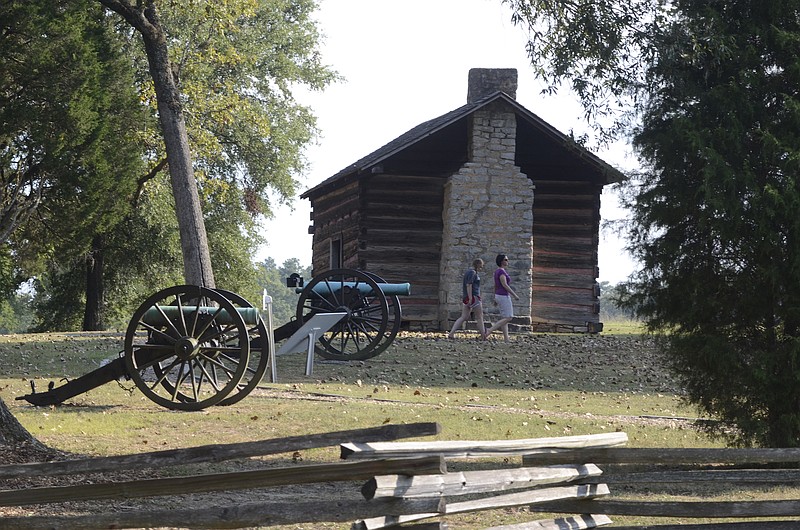One of many instances of our Civil War depicting the struggle of brother against brother is commemorated at the Kentucky monument on the Chickamauga battlefield, where Confederates from that state under the command of Maj. Gen. John C. Breckinridge fought Union troops, also from Kentucky. Breckinridge had previously served as vice president of the United States under Abraham Lincoln's predecessor, James Buchanan. Brig. Gen. Benjamin Hardin Helm, a subordinate of Breckinridge's, died at Chickamauga fighting on the opposite side of his brother-in-law, President Abraham Lincoln. Both were from Kentucky.
On Nov. 25, 1863, two months after Chickamauga, and after considerable disruption in the Confederate high command, Gen. Breckinridge found himself commanding three divisions on the Confederate left, extending from the approximate area where Bird's Mill Road now ascends the ridge to the south of Shallowford Road, all the way south to the gap at Rossville.
The main Federal effort against the Confederate line was directed against the northern end of the ridge, at today's Sherman Reservation. Simultaneously advancing across Chattanooga Valley was the Federal force commanded by Maj. Gen. "Fighting Joe" Hooker who had conquered Lookout Mountain the day before. Breckinridge was tasked with defending the Confederate left. Breckinridge's left-most division, that of Maj. Gen. Alexander P. Stewart, formed on either side of the Kentuckian's headquarters, was located in the area where the road to Ringgold crossed the ridge (today's Old Ringgold Road). Stewart's division, however, could not cover the ridge south to Rossville, leaving an interval of about a mile. A small force of about 600 Georgians was posted to cover the Rossville Gap.
Seeing the advancing column of about 9,000 Federals and not hearing from the 600 Peach State men at Rossville, Confederate commander Gen. Braxton Bragg and Breckinridge decided the latter would detach a brigade from Stewart and make a "reconnaissance" toward Rossville.
Serving on Gen. Breckinridge's staff was his teenage son, Lt. Joseph Cabell Breckinridge, a slightly built but confident young man, nattily dressed in gray and wearing an embroidered hat. Cabell was dispatched on his thoroughbred mare, Fannie, to advise the commander of the Georgians that help was on its way. Cabell approached the gap and found not Georgia Rebels, but Iowa Yankees. Riding Fannie furiously, the young Confederate officer tried to escape between the Iowans and the side of the ridge. Captured and conveyed into captivity, he boldly asserted the Confederates were winning the battle and then hugged and kissed his beloved horse goodbye. Fannie ended up a prize of war for Brig. Gen. Peter J. Oosterhaus, the commander of the Federal advance.
Gen. Breckinridge's personal loss was soon compounded by a military defeat, as Oosterhaus' column proceeded to the east side of the ridge, and two other Federal divisions advanced up the spine and on the western side of the Ridge. The detached Rebel brigade, commanded that day by Col. James T. Holtzclaw, was badly defeated by the convergence of those three forces as Breckinridge, Holtzclaw and about 700 of their men moved laterally north down the ridge to escape capture. In the overall Confederate defeat that day, many other Rebels joined Cabell (and Fannie) in captivity.
Fortunately for the Breckinridge family, both father and son survived the terrible night of Nov. 25. Young Cabell was transported to a POW camp in Ohio. He was exchanged in early 1864 and returned to duty on the staff of his father, who at that point commanded troops in southwest Virginia. The elder Breckinridge was later appointed the final Confederate Secretary of War.
Fearing an arrest for treason at the close of the war, Gen. Breckinridge made a daring escape to Cuba, but Cabell was allergic to mosquito bites, and his father told him to surrender, which he did at Tallahassee in May, 1865. Father and son were reunited in Toronto, Canada, and eventually returned to the United States. John C. Breckinridge died early at age 54 in 1873.
After the war Cabell was involved in business in Arkansas and St. Louis, and served as Surveyor General of the Washington Territory under President Grover Cleveland. Like his father, he died at the relatively early age of 61, from pernicious anemia at his son-in-law's home in Yonkers, N.Y., in 1906. Fannie's fate is unknown.
Sam D. Elliott is an attorney with Gearhiser, Peters, Elliott and Cannon and the author of "John C. Brown of Tennessee: Rebel, Redeemer and Railroader,"the winner of the 2017 Tennessee History Book Award. Visit Chattahistoricalassoc.org for more information.
